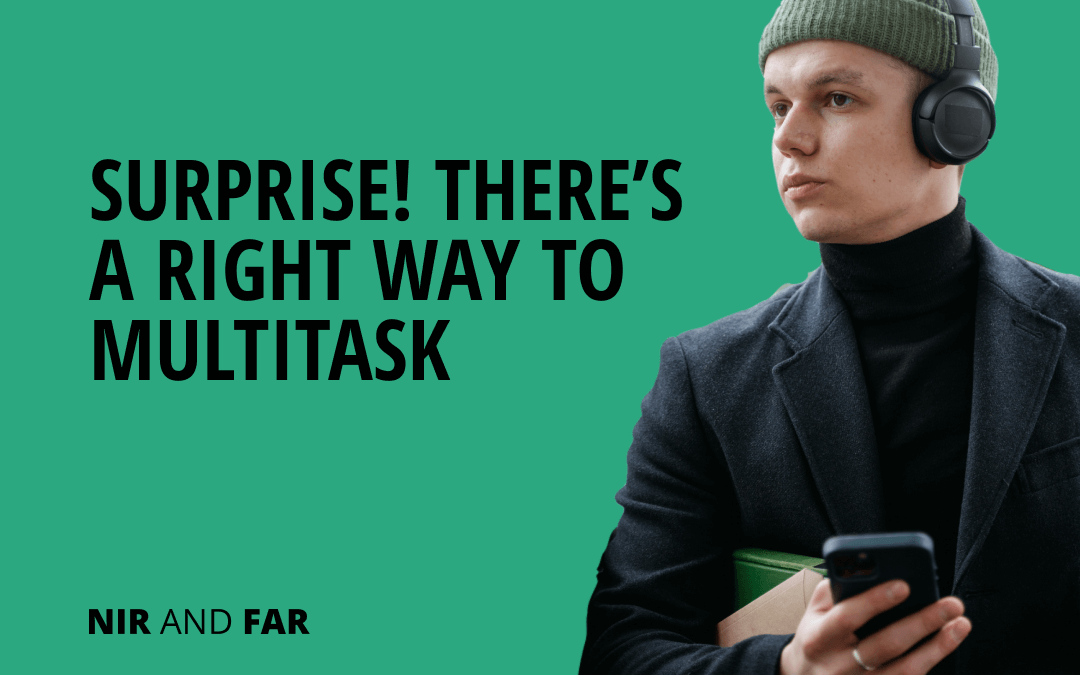Everyone knows that multitasking destroys productivity, right? Haven’t we all seen studies and read articles telling us that it’s impossible to do two things at once?
In some ways, that’s true. The evidence is pretty clear that humans are awful at performing two complex tasks simultaneously.
Generally speaking, we commit more errors when juggling many tasks at the same time, and we also take longer—sometimes double the time—to complete the tasks. Scientists believe this wasted and decreased proficiency occurs because the brain has to work hard to refocus attention.
However, bundling certain tasks is a great way to squeeze more from your day with little effort. You just need to figure out which ones to bundle.
Lucky for you, I developed a method that helps you do just that.
I call it “multichannel multitasking.”
Understand Your Brain’s Multitasking Limits
Before we can dive into what tasks can be done simultaneously, there are a few key things to know about the human brain.
- The brain has a limit on its processing horsepower—the more concentration a task requires, the less room it has for anything else. That’s why we can’t solve two math problems at the same time.
- The brain has a limited number of attention channels, and it can only make sense of one sensory signal at a time. You can’t listen to two different podcasts, one in each ear, without mentally tuning out one of them. We can only receive information from one visual or auditory source at a time.
- That said, we are perfectly capable of processing multichannel inputs—something scientists call “cross-modal attention.” It allows our brains to place certain mental processes on autopilot while we think about other things.
In fact, studies have found that people can do some things better when they engage multiple sensory inputs. Some types of learning are enhanced when people also engage their auditory, visual, and tactile senses at the same time.
So, under those guidelines, we know that we can’t bundle two complex tasks, and we can’t bundle tasks that require the same sensory input. But everything else is fair game.
Build Task Bundles
Your brain may not have the processing power to write a report and listen intently to a conference call at the same time, but you can pair one of those complex tasks with a lower-level task that uses a different sensory input.
For example, a recent study found walking, even if done slowly and on a treadmill, improved performance on a creativity test when compared to sitting down. That, and the fact that walking improves cognitive function and productivity, might explain why walking desks have become so popular. People are certainly capable of brainstorming ideas while walking one to two miles per hour, which is a great way to bundle work and exercise.
Likewise, stepping out of the office for a long walk while taking a phone call or inviting a colleague for a walking meeting checks off two positive things at once.
And multichannel multitasking goes beyond work: Cooking and eating a healthy meal with friends allows you to do something good for your body while also investing in your relationships. Listening to a nonfiction audiobook on the way to work is a good example of making the most of a commute while investing time in self-improvement. Doing the same while cleaning makes the chores seem to pass more quickly.
Sometimes one task can encourage us to do another, which is called “temptation bundling”—a super-effective motivation hack. The term was coined by Katherine Milkman at the University of Pennsylvania’s Wharton School, who ran a study in which participants were given an iPod loaded with an audiobook they could only listen to at the gym. Those participants made 51% more gym visits than those in the control group.
I take advantage of temptation bundling by only allowing myself to listen to my saved articles using the Pocket app (iOS/Android) with its text-to-speech capabilities when I am exercising or on a walk. Getting to consume those articles feels like a small reward and motivates me to work out or take a stroll again.
Multichannel multitasking is an underutilized tactic for getting more out of each day. We can build this technique into our schedules to help us make more time for traction and use temptation bundling to make activities, like exercising, more enjoyable.
Related Articles
- Schedule Maker: a Google Sheet to Plan Your Week
- Habit Tracker in Google Sheets – Free Template
- A List of 20 Values [and Why People Can’t Agree On More]
- Timeboxing: Why It Works and How to Get Started in 2024
- An Illustrated Guide to the 4 Types of Liars
- Hyperbolic Discounting: Why You Make Terrible Life Choices
- Happiness Hack: This One Ritual Made Me Much Happier


